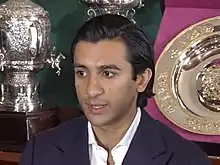Padmanabh Singh
Padmanabh Singh (born 2 July 1998) is an Indian Polo player and member of the erstwhile royal family of the Jaipur State.[1]
Padmanabh Singh | |
|---|---|
 | |
| Born | 2 July 1998 |
| Other names | Pacho |
| Alma mater | Mayo College Millfield School |
| Occupation | Polo player |
| Predecessor | Sawai Bhawani Singh |
| Parent | Diya Kumari |
| Relatives | Bhawani Singh (grandfather) Padmini Devi (grandmother) |
Personal life
Padmanabh Singh was born in New Delhi on 2 July 1998 to Diya Kumari, an Indian politician, and her husband, Narendra Singh.[1][2] He was educated at Mayo College in Ajmer[3] and at Millfield, a public school in Street, Somerset, England.[2] Since 2018, he has been enrolled in Università e Nobil Collegio Sant'Eligio in Rome, studying Cultural Heritage Management, Art History and Italian Language.[4] He is known as Pacho by his loved ones and friends. Pacho was nick-named by his grandmother a.k.a Rajmata Padmini Devi.
Singh is the great-grandson of Man Singh II, the last ruling Maharaja of the princely state of Jaipur in the British Raj, though the relationship is not patrilineal. Singh's mother is the only daughter of the late Bhawani Singh, an Indian soldier, hotelier, and the son of Man Singh II. His father is the son of a former member of staff of Bhawani Singh.[5][3] Singh's parents divorced in 2018.[4]
Upon Bhawani Singh's death in 2011, the 12-year-old Padmanabh Singh was unofficially installed as the "Maharaja of Jaipur".[3] Although princely pensions, titles, and privileges were officially abolished in India in 1971, families of some former princely rulers have continued to use the old titles unofficially for certain family members or styled new ones for themselves. In some instances the titles are used for the purpose of officiating in family ceremonies and traditions; in others, they are thought to be used with a view to promoting the allure that princely India holds among tourists, and to sustaining the wealth, stardom, and clout that the families have retained.[6]
Polo
Padmanabh Singh began playing competitive polo in 2015 in England and has been a member of Guards Polo Club.[7] In 2017, he led the Indian national team at Hurlingham Park in what was the first visit to the venue by an Indian team in over 70 years. His grandfather had led the last successful Indian polo tour of the UK.[8][9]
References
- "Meet the 20-year-old 'king' of Jaipur, India, a polo star who spends his multimillion-dollar fortune traveling the world and studying in NYC and Rome". Business Insider. 31 December 2018.
- Parihar, Rohit (2 July 2016). "City Palace in Jaipur celebrates Maharaja Padmanabh Singh's 18th birthday". India Today.
- "Indian schoolboy, 12, crowned Maharaja". NEWS.com.au. 28 April 2011. Retrieved 1 August 2017.
- 247 News Around the World (2 August 2021), The most glamorous royal family you've NEVER heard of! Meet the VERY glossy posse at Jaipur's palace from the king, 23, worth £500 million who's modelled for D&G to his fashion designer sister, Daily Mail
- Bhandari, Prakash (16 September 2013). "The princess who could provide a royal touch to the BJP". Rediff. Retrieved 1 August 2017.
-
- Karatchkova, Elena (2016) [2007], "Ghost Towns and Bustling Cities: Constructing a Master Narrative in Nineteenth-Century Jaipur", Raj Rhapsodies: Tourism, Heritage, and the Seductions of History, p. 30, ISBN 9781317071624,
The contemporary master narrative for Jaipur and Amber is 'royalty'. This theme is ubiquitous in tourist publications, such as Majestic Jaipur (Wheeler 1998). Royal personalities are emphasized, as in Jaipur: The Royal City. One article on tourist attractions of Jaipur features a full-page photograph of Maharaja Bhawani Singh, in full regalia, with his wife and daughter, all identified as 'the present royal family'
- Aldrich, Robert; McCreery, Cindy (2016), "European sovereigns and their empires 'beyond the seas'", in Robert Aldrich, Cindy McCreery (ed.), Crowns and colonies: European monarchies and overseas empires, Studies in Imperialism Book 142, Manchester University Press, p. 43, ISBN 9781526100894,
Although Prime Minister Indira Gandhi deprived the India princes of their official titles and privy purses in 1971, the maharajas and other princes, such as the traditional Maharana of Udaipur, who now styles himself as the 'Custodian' of the House of Mewar in Rajasthan, retain wealth, influence and celebrity; in 2015, a twenty-three-year-old economics graduate was thus installed as the most recent Maharajah of Mysore.
- Ramusack, Barbara N. (2004). The Indian princes and their states. Cambridge University Press. p. 279. ISBN 978-0-521-26727-4.
The princes of India offer fantasy for post-modern consumption. Faced with escalating maintenance costs and declining sources of income, princely entrepreneurs transformed palaces into hotels where tourists could experience an idealised, pampered lifestyle of royalty during a democratic era. In 1954 Karan Singh of Jammu and Kashmir leased his main palace in Srinagar to the Oberoi chain; it seems appropriate that he became minister for tourism and civil aviation in 1967 in Indira Gandhi's government. In 1958 the Rambagh Palace Hotel opened in Jaipur followed by the much photographed Lake Palace Hotel in Udaipur in the early 1960s
- Karatchkova, Elena (2016) [2007], "Ghost Towns and Bustling Cities: Constructing a Master Narrative in Nineteenth-Century Jaipur", Raj Rhapsodies: Tourism, Heritage, and the Seductions of History, p. 30, ISBN 9781317071624,
- "The Polo Prince". Outlook Business. 11 November 2016. Retrieved 1 August 2017.
- Telegraph Sport (6 April 2017). "England polo to play India at Hurlingham". The Daily Telegraph. Retrieved 1 August 2017.
- "England International". Sportsgate International. Archived from the original on 22 July 2017. Retrieved 1 August 2017.